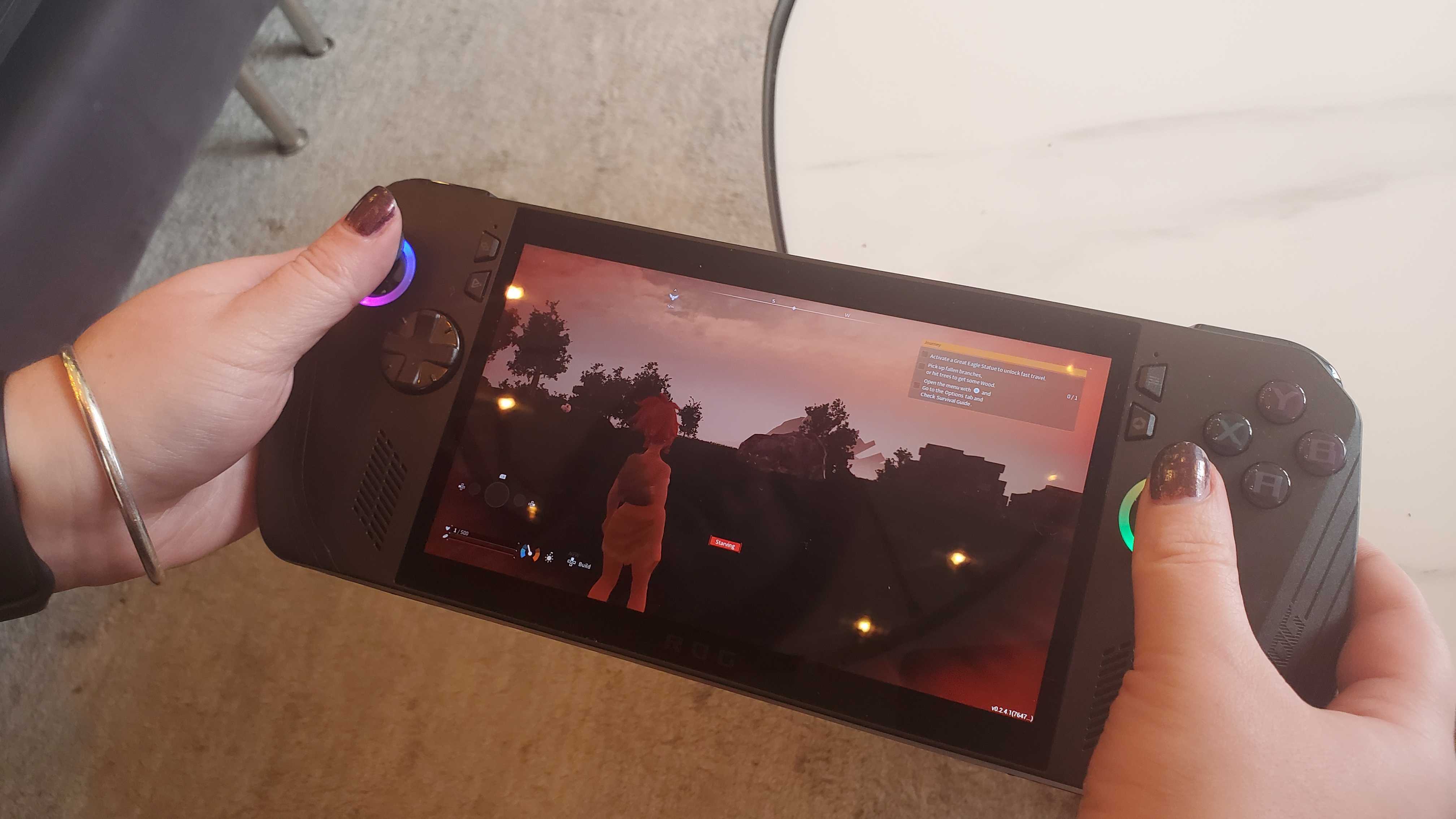Steam Deck vs Asus ROG Ally X: which is the best PC gaming handheld?
The PC gaming handheld powerhouses


CPU: AMD Zen 2 four core 2.4-3.5GHz
Graphics: AMD RDNA 2
RAM: 16GB LPDDR5
Screen: 7-inch, 1,280 x 800 touchscreen, 60Hz
Storage: Up to 512GB PCIe SSD
Ports: USB-C, 3.5mm headphone jack, microSD
Connectivity: Wi-Fi 5, Bluetooth 5
Weight: 1.47 pounds (0.67kg)
Dimensions (W x D x H): 11.73 x 4.6 x 1.9 inches (29.8 x 11.7 x 4.9cm; W x D x H)
The original PC gaming handheld is still one of the best, but it's got some strong competition from Asus's ROG Ally X.

CPU: AMD Ryzen Z1 Extreme
Graphics: AMD Radeon Graphics
RAM: 24GB LPDDR5X-7500
Screen: 7-inch FHD (1920 x 1080), 120Hz, 500 nits
Storage: 1TB M.2 2280 SSD
Ports: 2x USB Type-C ports, 1x combo jack, 1x SD card reader slot
Connectivity: Wi-Fi 6E, Bluetooth 5.2
Weight: 1.49 pounds (678g)
Dimensions (W x D x H): 11.02 x 4.37 x 1.45 inches (28.0 x 11.1 x 3.69 cm)
The most recent PC gaming handheld on the market has some serious chops, but can it finally unseat the Steam Deck?
Valve's Steam Deck kicked off a whole new PC gaming handheld market, and several other PC gaming brands have since released their own PC portable machines like the Asus ROG Ally, MSI Claw, and Lenovo Legion Go.
Now, Asus has launched the Asus ROG Ally X, a revamped version of its original Asus ROG Ally handheld.
But how does this PC handheld hold up against the Steam Deck, the current champ of PC handhelds? I'll compare the two, looking at their specs, price points, performance, and features to see which is the better purchase overall.
Steam Deck vs Asus ROG Ally X: price

Valve’s Steam Deck launched in 2022 and starts at $399 / £349 /AU$649 for its 256GB LCD model. The new OLED versions will run you $549 / £479 / AU$899 for the 512GB model and $649 / £569 / AU$1,049 for the 1TB model.
The Asus ROG Ally X retails at $799.99 / £799 / AU$1,599 and launched in 2024. There's only one model and it comes with 24GB of RAM and 1TB of storage.
For price, the Steam Deck is the winner between the two handhelds. Even the OLED models are cheaper than the far more expensive ROG Ally X.
Steam Deck vs Asus ROG Ally X: design & features

The original Asus ROG Ally was much smaller and lighter than the Steam Deck and other PC gaming handhelds, with a unique honeycomb white chassis that made it stand out. But the ROG Ally X is much closer to the Steam Deck now due to the enhanced specs.
Sign up for breaking news, reviews, opinion, top tech deals, and more.
They both sport dual analog sticks, a black chassis, a 7-inch screen, and buttons in the front and back of the system. Both also have ventilation exhausts on the top of the system to compensate for the massive amounts of heat generated by their components.
Their button layout and grips are also quite similar, though the ROG Ally X has better analog sticks that you can customize the grip on. The Steam Deck is now slightly lighter and smaller, with an OLED model that upgrades the display even more.
In terms of design, both systems are tied as they're extremely similar in specs with slight differences between them - what appeals to you is based more on preference than superiority.
Steam Deck vs Asus ROG Ally X: specs

Here’s a full breakdown of the Steam Deck’s specs:
| Size | 298mm x 177mm x 49mm (W x H x D) |
| Weight | Approx 669 grams |
| CPU | AMD Zen 2 4c/8t |
| GPU | 8 RDNA 2 CUs |
| RAM | 16GB LPDDR5 RAM |
| Storage | 64GB eMMC / 256GB NVMe SSD / 512GB NVMe SSD (all models include high-speed microSD card slot) |
| Display resolution | 1280 x 800px (16:10 aspect ratio) |
| Display size | 7-inch diagonal |
| Brightness | 400 nits typical |
| Refresh rate | 60Hz |
| Touch enable | Yes |
| Connectivity | Bluetooth 5.0 |
| Audio | Stereo speakers |
| Power | 45W USB Type-C |
| Battery life | 2 to 8 hours of gameplay |
| Operating system | SteamOS 3.0 |
Here’s a full breakdown of the Asus ROG Ally X’s vital statistics:
| Size | 11.02 x 4.37 x 0.97 ~ 1.45 inches (28.0 x 11.1 x 2.47 ~ 3.69 cm; W x D x H) |
| Weight | 1.49 lbs (678 g) |
| Resolution | FHD (1920 x 1080) |
| CPU | AMD Ryzen Z1 Extreme |
| GPU | AMD Radeon Graphics |
| RAM | 24GB LPDDR5X-7500 |
| Storage | 1TB M.2 2280 SSD |
| Brightness | 500 nits |
| Refresh rate | 120Hz |
| Touch enable | Yes |
| Connectivity | Wi-Fi 6E(802.11ax) 2*2 + Bluetooth® 5.2 |
| Audio | Stereo speakers |
| Power | 65 Wh USB Type-C |
| Operating system | Windows 11 |
| Video output | 1080p |
| USB connector | USB Type-C for charging |
| 3.5mm headphone jack | Row 16 - Cell 1 |
| Battery life | approximately 3 to 5 hours of gameplay |
| Charging time | approximately 3 hours |
Steam Deck vs Asus ROG Ally X: performance

On the performance front, when using Turbo Mode, the Asus ROG Ally X is more powerful thanks to its superior processor and specs, more than matching the Steam Deck in gaming performance. So even though both portables have the same screen size and resolution, games look much cleaner on the ROG Ally X.
For example, I tested both handhelds using Cyberpunk 2077 and Forza Horizon 5, and with Forza Horizon 5, the ROG Ally X had ray tracing enabled and even on High settings was able to get more than 50 FPS. The downside is that Turbo Mode depletes the battery life extremely quickly, meaning that you need to keep it on AC power for the most mileage.
When it came to an even more demanding game like Cyberpunk 2077, the Steam Deck on Medium settings averaged around 26fps. On the ROG Ally X, however, it was unplayable at less than 10fps unless you turned down the graphical settings.
The Steam Deck has the superior OS, bar none. Armory Crate is much smoother and more streamlined on the ROG Ally X but Windows 11 still runs very poorly on PC gaming handhelds generally. Meanwhile, the Steam Deck's OS is built specifically for the system, so it's faster to start up and more intuitive to use.
While it's close, the Steam Deck eeks out a win here too. Though the ROG Ally X can sometimes handily beat out the Steam Deck in performance, the latter is also far more consistent from game to game. The Steam Deck has a far superior OS as well.
Steam Deck vs Asus ROG Ally X: verdict
So which is the better purchase? The Steam Deck holds on to its crown.
The Steam Deck offers the perfect balance of price, portability, and performance, letting you play the best PC games with a great OS and good battery life given its specs. If you're just starting out with this kind of handheld, the Steam Deck is the best choice.
And while the Asus ROG Ally X is objectively a much better portable than its predecessor, it still loses out in key areas. It no longer has the style and portability of the base model, the performance has the potential for greatness but also has trouble with other demanding games, and the price is much more expensive when comparing similar models.
Recently purchased a Steam Deck or Asus ROG Ally X? Consider checking out our list of the best Steam games and best PC games to get your collection going on either device.

Named by the CTA as a CES 2023 Media Trailblazer, Allisa is a Computing Staff Writer who covers breaking news and rumors in the computing industry, as well as reviews, hands-on previews, featured articles, and the latest deals and trends. In her spare time you can find her chatting it up on her two podcasts, Megaten Marathon and Combo Chain, as well as playing any JRPGs she can get her hands on.